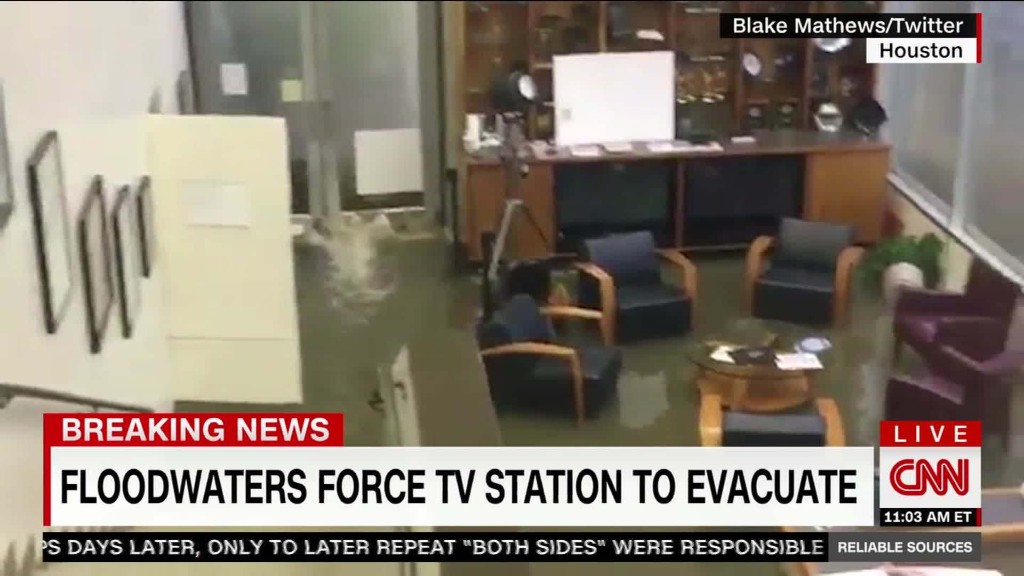
We're finding out what a major flood emergency looks like in the era of social media.
Hundreds of stranded Texas residents sought help on Sunday by posting on Facebook and Twitter. They tweeted their addresses to emergency officials. They organized rescue missions through Facebook groups. And they posted harrowing pictures to emphasize just how high the flood waters were.
Requests for rescues were common: "Anyone in North Houston have a boat and can rescue a 3 &6 yo, mom, gramma and grandpa and 2 dogs?"
Some particularly web-savvy officials responded to the requests nearly in real time.
We have seen this kind of web-enabled emergency response in other countries before, but never in the United States on this scale.
Related: Houston TV station forced off air as crews evacuate ahead of floodwater
In fact, the last time a "major" hurricane made landfall, in 2005, Twitter didn't even exist. (The U.S. government defines a "major" hurricane as a Category 3 or higher storm.)
Hurricane Harvey crashed into the Texas coast as a Category 4 storm on Friday night, and has been dumping rain over a wide swath of south Texas ever since.
Late Saturday night and into Sunday morning, extremely heavy bands of rain swamped the Houston metro area, sending untold thousands of people scrambling for dry land.
A lot of residents relied on local TV and radio for information, but reached for their smartphones to seek help.
Related: Corporate America donates millions to Harvey relief
In many parts of the city and surrounding communities, cell phone towers were functional despite the flooding rains. So citizens were able to read updates from local officials and post their own updates. That's why urgent requests for rescues piled up on Houston-area Facebook pages. Some local journalists who spotted the posts vigilantly forwarded the messages to authorities.
"My family is still waiting for a water rescue in the attic, they can't get to roof!" Twitter user @AlyxandriaErryn wrote Sunday morning. She tweeted out the family's address. The message was reposted by thousands of people.

Art Acevedo, Houston's chief of police, fielded those messages. Throughout the day he kept tweeting updates and live video streams from around the area.
Harris County Sheriff Ed Gonzalez similarly used Twitter as a megaphone. At 4 a.m. Sunday, he alerted followers to the whereabouts of a "pregnant woman going into labor." He copied Houston's fire department on the message.
A photo of soaking-wet elderly patients at La Bella Vita nursing home in Dickinson, just southeast of Houston, went viral after a Florida woman, Kim McIntosh, posted it on Sunday.
Related: Nursing home residents rescued after waiting in several feet of water
McIntosh told CNN that she posted it out of desperation -- her mother owns the nursing home and was having a hard time getting help.
McIntosh said she shared the photo "to try get as much attention" from people who could "get there with a boat."
The nursing home was evacuated on Sunday afternoon.
As the flooding worsened, some officials emphasized that posting on social media should not be construed as a replacement for calling 911. "Do not report your information on social media sites," the U.S. Coast Guard said Sunday, urging people in distress to call instead.
But Facebook (FB) and Twitter (TWTR) were clearly used as a supplement -- if not a replacement -- for traditional emergency services.
"We've got a lot of calls coming in on Facebook right now," a rescuer told CNN correspondent Brian Todd in Houston on Sunday night.
Related: Gas prices set to spike as Harvey pummels Houston
As much as social media can help in a crisis, Harvey has also provided a vivid demonstration of how it can hurt.
False information about rescue operations was spread via social media on Sunday, along with years-old photos that purported to be from the current flood.
Local officials tried to quash the rumors and false stories through the same social networks it was spread on.
This was a problem even before the first raindrops fell on Friday. The Houston mayor, Sylvester Turner, said that "false forecasts and irresponsible rumors on social media" were interfering with the city's efforts to inform the public.
He told residents to "continue to monitor mainstream news sources for updates on the weather."


